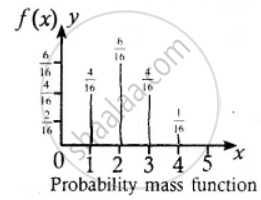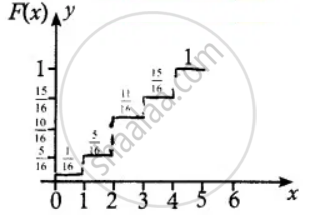Advertisements
Advertisements
Question
Find the probability mass function and cumulative distribution function of a number of girl children in families with 4 children, assuming equal probabilities for boys and girls
Solution
Let X be the random variable denotes the number of girl child among 4 children
X = {0, 1, 2, 3, 4}
| Values of the random variable | 0 | 1 | 2 | 3 | 4 | Total |
| Number of elements in inverse image | 1 | 4 | 6 | 4 | 1 | 16 |
(i) Probability mass function
| x | 0 | 1 | 2 | 3 | 4 | Total |
| f(x) | `1/16` | `4/16` | `6/16` | `4/16` | `1/16` | 1 |

(ii) Cumulative distribution
F(x) = P(X ≤ x)
= `sum_(x_"i" ≤ x) "P"("X" = x_"i")`
P(X < 0) = 0 for `- oo < x < 0`
F(0) = P(X ≤ 0)
= `P(X = 0)
= `1/16`
F(1) = P(X ≤ 1) = P(X = 0) + P(X = 1)`
= `1/16 + 4/16`
= `5/16`
F(2) = P(X ≤ 2)
= P(X = 0) + P(X = 1) + P(X = 2)
= `1/16 + 4/16 + 6/16`
= `11/16`
F(3) = P(X ≤ 3)
= P(X = 0) + P(X = 1) + P(X = 2) + P(X = 3)
= `1/16 + 4/16 + 6/16 + 4/16`
= `15/16`
F(4) = P(X ≤ 4)
= P(X = 0) + P(X = 1) + P(X = 2) + P(X = 3) + P(X = 4)
= `15/16 + 1/16`
= 1
F(x) = `{{:(0",", "For" x < 0),(1/16",", "For" x ≤ 0),(5/16",", "For" x ≤ 1), (11/16",", "For" x ≤ 2),(15/16",", "For" x ≤ 3),(1",", "For" x ≤ 4):}`

APPEARS IN
RELATED QUESTIONS
Suppose error involved in making a certain measurement is continuous r.v. X with p.d.f.
f (x) = k `(4 – x^2 )`, for –2 ≤ x ≤ 2 and = 0 otherwise.
P(x > 0)
Suppose error involved in making a certain measurement is continuous r.v. X with p.d.f.
`"f(x)" = {("k"(4 - x^2) "for –2 ≤ x ≤ 2,"),(0 "otherwise".):}`
P(–1 < x < 1)
Given the p.d.f. of a continuous r.v. X ,
f (x) = `x^2/ 3` , for –1 < x < 2 and = 0 otherwise
Determine c.d.f. of X hence find P( X > 0)
The p.m.f. of a r.v. X is given by P (X = x) =`("" ^5 C_x ) /2^5` , for x = 0, 1, 2, 3, 4, 5 and = 0, otherwise.
Then show that P (X ≤ 2) = P (X ≥ 3).
In the p.m.f. of r.v. X
| X | 1 | 2 | 3 | 4 | 5 |
| P (X) | `1/20` | `3/20` | a | 2a | `1/20` |
Find a and obtain c.d.f. of X.
Solve the following problem :
A player tosses two coins. He wins ₹ 10 if 2 heads appear, ₹ 5 if 1 head appears, and ₹ 2 if no head appears. Find the expected value and variance of winning amount.
It is felt that error in measurement of reaction temperature (in celsius) in an experiment is a continuous r.v. with p.d.f.
f(x) = `{(x^3/(64), "for" 0 ≤ x ≤ 4),(0, "otherwise."):}`
Find P(0 < X ≤ 1).
Fill in the blank :
The values of discrete r.v. are generally obtained by _______
Solve the following problem :
Identify the random variable as discrete or continuous in each of the following. Identify its range if it is discrete.
Amount of syrup prescribed by a physician.
Solve the following problem :
Identify the random variable as discrete or continuous in each of the following. Identify its range if it is discrete.
A highway safety group is interested in the speed (km/hrs) of a car at a check point.
Out of 100 people selected at random, 10 have common cold. If five persons selected at random from the group, then the probability that at most one person will have common cold is ______.
Three fair coins are tossed simultaneously. Find the probability mass function for a number of heads that occurred
A six sided die is marked ‘1’ on one face, ‘3’ on two of its faces, and ‘5’ on remaining three faces. The die is thrown twice. If X denotes the total score in two throws, find the probability mass function
A random variable X has the following probability mass function.
| x | 1 | 2 | 3 | 4 | 5 |
| F(x) | k2 | 2k2 | 3k2 | 2k | 3k |
Find P(2 ≤ X < 5)
A random variable X has the following probability mass function.
| x | 1 | 2 | 3 | 4 | 5 |
| F(x) | k2 | 2k2 | 3k2 | 2k | 3k |
Find P(X > 3)
Choose the correct alternative:
A pair of dice numbered 1, 2, 3, 4, 5, 6 of a six-sided die and 1, 2, 3, 4 of a four-sided die is rolled and the sum is determined. Let the random variable X denote this sum. Then the number of elements in the inverse image of 7 is
If the probability function of a random variable X is defined by P(X = k) = a`((k + 1)/2^k)` for k - 0, 1, 2, 3, 4, 5, then the probability that X takes a prime value is ______
A random variable X has the following probability distribution:
| X | 1 | 2 | 3 | 4 |
| P(X) | `1/3` | `2/9` | `1/3` | `1/9` |
1hen, the mean of this distribution is ______
Two coins are tossed. Then the probability distribution of number of tails is.
The c.d.f. of a discrete r.v. X is
| X = x | -4 | -2 | -1 | 0 | 2 | 4 | 6 | 8 |
| F(x) | 0.2 | 0.4 | 0.55 | 0.6 | 0.75 | 0.80 | 0.95 | 1 |
Then P(X ≤ 4|X > -1) = ?
